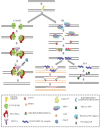Ionizing radiation-induced DNA injury and damage detection in patients with breast cancer
- PMID: 26692152
- PMCID: PMC4763322
- DOI: 10.1590/S1415-475738420150019
Ionizing radiation-induced DNA injury and damage detection in patients with breast cancer
Abstract
Breast cancer is the most common malignancy in women. Radiotherapy is frequently used in patients with breast cancer, but some patients may be more susceptible to ionizing radiation, and increased exposure to radiation sources may be associated to radiation adverse events. This susceptibility may be related to deficiencies in DNA repair mechanisms that are activated after cell-radiation, which causes DNA damage, particularly DNA double strand breaks. Some of these genetic susceptibilities in DNA-repair mechanisms are implicated in the etiology of hereditary breast/ovarian cancer (pathologic mutations in the BRCA 1 and 2 genes), but other less penetrant variants in genes involved in sporadic breast cancer have been described. These same genetic susceptibilities may be involved in negative radiotherapeutic outcomes. For these reasons, it is necessary to implement methods for detecting patients who are susceptible to radiotherapy-related adverse events. This review discusses mechanisms of DNA damage and repair, genes related to these functions, and the diagnosis methods designed and under research for detection of breast cancer patients with increased radiosensitivity.
Figures



References
-
- Alapetite C, Thirion P, De la Rochefordie A, Cosset JM, Moustacchi E. Analysis by alkaline comet assay of cancer patients with severe reactions to radiotherapy: Defective rejoining of radioinduced dna strand breaks in lymphocytes of breast cancer patients. Int J Cancer. 1999;90:83–90. - PubMed
Internet Resources
LinkOut - more resources
Full Text Sources

